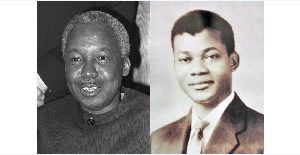is the childhood attachment experience the cause (answer)?
Introduction and background
It has been widely discussed in scientific literature that if a child experiences negative relationship with his primary caregiver during the early childhood period, it tends to render the responses from the lower-brain of the child more dominant and that hinders his cognitive regulating structures from developing to their full capacity; thus, children who acquire such experience may have difficulty with controlling their emotions and understanding others' emotions (Kraemer, 1992 cited in Child Welfare Information Gateway (CWIG), 2001).
Mr Rawlings' behaviour seems to fit into the category of people who experience early childhood attachment difficulties. From the very moment he burst onto the Ghanaian political scene in 1979 till today, it seems that Mr Rawlings always wants to have everything in his own way. For instance, not long ago Mr Rawlings is reported to have stated: “that short man, what is his name, Nana Akufo-Addo” at Asantehene’s palace. And no longer after that statement, he again described Nana Akuffo Addo as “a disabled hunchback and too short to become the president of Ghana” at a rally he held at Tachiman Zongo. In fact, to discuss the disgusting behaviour of Mr Rawlings is beyond the scope of this paper. However, an attachment to this paper outlines some of his awkward behaviours. I am therefore using the rest of my discussion to expand on the purpose of this paper. In order to understand Mr Rawlings behaviour, it is perhaps necessary to examine:
? the circumstance of his birth and his mother's possible state of mind at the time; ? the possible type of attachment (bonding) that he might have experienced with his mother during his early childhood; ? how he might have perceived himself among his peers as a ‘half caste’ growing up among indigenous Africans; and ? whether the impact of any of the above issues may be causing the continual appalling behaviour of Mr Rawlings.
The attachment theory and the circumstance of JJ’s birth
Attachment is the emotional relationship formed between two people and it provides the basis for future long-term relationships with other persons (AAP, 2000; Perry, 2000). However, evidence from research suggests that if a child does not have appropriate attachment experience with his primary carer, it may affect his development and the impact of that can last for the rest of his life. In addition, it has been established that when women experience antenatal and postnatal depression, it may affect their ability to provide appropriate attachment to their children. Moreover Kowalenko, Barnett, Fowler and Matthey (2000) for instance, have identified the following as some of the risk factors of antenatal and postnatal depression:
? a problematic marriage relationship and lack of support from partner;
? a recent significant bereavement or an experience of multiple social stressors (e.g. financial strain, moving house or unemployment); and
? fatigue and inadequate energy.
Further, the website - Answers.com website (http://www.answers.com/topic/jerry-rawlings) discusses the circumstance that Mr Rawlings was born as follows:
“Rawlings was born to the Scottish pharmacist James Ramsay John and his Ghanaian Ewe mistress, Victoria Agbotui. His father had migrated to the then Gold Coast in 1935 with his wife Mary to work for the United Africa Company (UAC). In 1941 he started an affair with Madam Agbotui, then a caterer at the State House in Ghana. The relationship ended in 1947, the same year that Rawlings was born. James John refused to acknowledge Rawlings as his son - right up until his death in 1982.
In order not to let her son lose his Scottish heritage, his mother named him after his father as Jeremiah Rawlings John. This name was later changed to Jerry John Rawlings following a clerical error when the young Rawlings signed up at the Royal Air Force. His mother hoped for a career as a medical doctor for her son and enrolled him at the prestigious Achimota School. However, Rawlings disciplinary problems prevented him from completing his General Certificate of Education Ordinary Level. He later admitted that his mother's strictness was part of what made him a rebellious kid”.
It appears that the circumstance that Madam Agbotui conceived and gave birth to Mr Rawlings is similar to the risk factors of the antenatal and postpartum depression mentioned above. As indicated above, her relationship with Mr John (the father of Mr Rawlings) broke down in the same year that Mr Rawlings was born, and who knows whether it was because of her pregnancy that caused the relationship breakdown. Moreover, she also had to raise the child herself without any form of partner support. All these factors made her very much vulnerable to postnatal depression.
Again, it has been suggested that parental mental illness increases the potential risk of child abuse and/or neglect, as severe mental illness may interfere with the ability of a parent to properly care and protect her child (Department of Human Services – Victoria (DHSV), 2007). In addition, children of mothers or parents with major depression commonly experience attachment difficulties, as they are unable to bond properly with those parents (DHSV, 2007). For instance, depressed mothers may experience parenting problems such as decreased awareness or sensitivity to infants’ emotional cues, and negative maternal perceptions of infants (Kowalenko et al., 2000). I will explain in detail what attachment is in the later part of this paper.
Moreover, the type of early attachment or bonding experience with parent(s) may contribute to the development of prosocial or antisocial behaviours in adulthood (Nathanson, 1996 cited in Hojat, 2004). For instance, a study by Weingberg and Tronick, 1998 (cited in Craig, 2004) identified that mothers with mental illness experience difficulties when interacting with their infants, as the infants demonstrate more "negative affect, less interest, more anger and sadness and a greater tendency to fuss and cry than infants in the control group". Similarly, a study by Jacon and Johnson, 2001 (cited in Marshall & Harper-Jaques, 2008) identified that parental depression correlates with the difficulty of children to adjust. In addition, Brunette and Dean (2002) have suggested that when women suffer mental illness they may include their children in their delusional system, which may compromise the care and safety.
Attachment theory and its effects
As discussed above, given the circumstance of Madam Agbotui’s pregnancy and birth of Mr Rawlings, she was highly susceptible to antennal and postnatal depression and parents experiencing postnatal depression and other mental disorders may have difficulty with providing appropriate care to their children. However, in order to develop the emotional security and social conscience, a child requires a secure (appropriate) attachment to a primary caregiver (Liberman & Zeanah, 1995 cited in AAP, 2000).
Further, children who suffer attachment disorders have problem trusting and loving others and when they become adults, they harbour anger and pain against the society (Werneer & Smith, 1982 cited in American Academy of Pediatrics (AAP), 2000). Again, aggression and cruelty have been identified with children that did not have proper attachment with their primary caregiver, as these children do not have empathy and appropriate impulse control (Perry, 2000). It is also argued that much of the violence in the US may be related to lack of appropriate attachment in the early childhood (Perry, 1996 cited in Shore, 1997)
The attachment and brain
It is believed that the type of attachment that children have with their primary caregivers and the environment that the children grow in have significant impact on the brain development. And since the brain regulates all the body functions, the way that the brain develops also have impact on how we function as human beings. Therefore, while genetics appears to predispose the ways humans develop, the environmental interactions significantly influence how the predispositions will be expressed, as the environmental interactions organise our brain's development and, therefore, shape the person we become (Shore, 1997). The process of brain development (synapses) involves the creation, strengthening and discarding of connections among the neurons, and is much influenced by the environment (Ounce of Prevention Fund, 1996 cited in CWIG, 2001).
Further, the critical anatomic brain structures that govern personality traits, learning processes, and coping with stress and emotions are formed, strengthened, and made permanent during the first 3 to 4 years of life, despite that the various parts of the brain form during the foetal period (Turner & Greenough, 1985 cited in AAP, 2000: Perry, 2000). According to Schiller (2000), while nature lays down the brain’s complex circuitry systems, the external and environmental factors such as nutrition and stimulations determine how the brain is wired.
Sensitive Periods of the brain development The initial synapses of the brain are weak and must be reinforced repeatedly by experiences within a certain timeframe to activate and strengthen them (CWIG, 2001). If this does not happen, the pathways to be developed in response to those experiences may be discarded, and this will affect the occurrence of the related functions that should be developed (Greenough, Black & Wallace, 1987 cited in CWIG, 2001). Thus, the brain development is non-linear because there are sensitive periods for acquiring different types of skills and knowledge and that usually occurs during the early years of life (Shore, 1997). Environmental influence (Plasticity), stress and adaptation of the brain The process where by the environment influences the way the brain creates, strengthens, and discards synapses and neuronal pathways is known as plasticity (Ounce of Prevention Fund, 1996 cited in CWIG, 2001). According to Shonkoff and Phillips, 2000 (cited in CWIG, 2001), plasticity is a two-edged sword, which leads to both adaptation and vulnerability. Therefore, the experiences of a child in early years of life to a considerable degree influence the development of her brain and consequently, the way she will interact with the world throughout her life (Ounce of Prevention Fund, 1996 cited in CWIG, 2001). Thus, negative experiences such as lack of stimulation, child abuse and trauma may impact negatively on the brain development because the brain reacts to a negative environment just as it adapts to a positive environment (Perry, 2000).
Long term effects
If children have negative experience they may develop emotional, behavioural, and learning problems that may last into their adulthood, if the situation is not intervened (McCain & Mustard, 1999). For instance, a child brought up in violent home may experience negative developmental problems that may lead to adverse responses to stress later in life (McCain & Mustard, 1999). Harry Chugani, 1997 (cited in Shore, 1997) argues that ‘… We can have individuals who, based on early experiences, are in effect "hard-wired" for negative behaviours’.
David Hubel, 1963 (cited in McCain & Mustard, 1999) concluded in his study that “early deprivation social interaction, such as contacts with a mother, may lead to mental disturbances that have their counterparts in actual structural abnormalities in the brain". Moreover, Rutter et al., 1998 (cited in McCain & Mustard, 1999) studied the root causes of youth antisocial behaviour and criminal activity and concluded that disruptive behaviour in preschool period was the major cause of repeated youth criminal activity.
The perception of Mr Rawlings as he was growing up
Notwithstanding the discussion made so far, there is the possibility that as Mr Rawlings was growing up, he might have considered himself as a special person. As a ‘half caste’ he might have regarded himself as ‘first among equals’ and that he is superior to others. If that was the case, there is the possibility that that this might have also contributed to his awful character. As he was growing up he might have probably got away when he did something bad and for that reason, he has grown up not appreciating that in this world, one person’s decision is not always the best. It therefore appears as no coincidence that Mr Rawlings is said to have “admitted that his mother's strictness was part of what made him a rebellious kid”.
Conclusion
The foregoing discussion has demonstrated that the environment in which a child is brought up has significant impact on his brain and interpersonal developments, among others. Further, negative environment and insecure attachment may affect a child development, and the consequence can last throughout his life. I also discussed that many women experience antenatal and postnatal depression and that may impact negatively on the development of their children, particularly, if the situation persists for a long period.
While we do not know definitely whether Madam Agbotui suffered antennal and postnatal depression and other forms of mental disorder, what we know is that the circumstance surrounding her pregnancy and birth of Mr Rawlings made her very vulnerable to antenatal and postnatal mental disorder such as depression. Further, Mr Rawlings’ behaviour seems to fit him into the category of people that suffer attachment difficulties in early childhood. Therefore, it appears plausible that the childhood attachment experience of Mr Rawlings may be contributing to his continuous appalling behaviour.
In any case, what ever the circumstance was, one thing that cannot be ruled out is the fact that Mr Rawlings’ appalling behaviour that we have seen since May 1979, seems to have its root cause from his childhood.
Author: J K Amponsah
Appendix
Mr Rawlings first emerged on Ghanaian political scene by the use of gun. In his first coup attempt, he was captured and as his case was being decided Captain Boakye-Gyan staged a successful coup and released Mr Rawlings and made him the head of state. It must be stressed that when Rawlings and Boakye-Gyan staged their coups, General Akuffo had already initiated a process committing Ghana to a return to a civilian government, after many years of Generals Acheampong and Akuffo’s military rule. Therefore, Rawlings and Boakye-Gyan’s coups were not necessary, and if anything at all, it was when Acheampong was burnt on imposing the so called “Union Government” on us that perhaps, a military intervention would have been justified. During the three months of Rawlings and Boakye-Gyan’s AFRC rule, past military leaders were killed by them, although, they were not given any chance to defend themselves. Women were stripped naked and caned in public when they were found to be wearing trousers and so forth. I wonder if Mr Rawlings’ daughters living in Europe don’t wear trousers. The second phase of Mr Rawlings rule begun after he overthrew Dr Limann, the civilian government that he himself had organised elections and handed power over to. The ordeal that Ghanaians went through in the phase II of Mr Rawlings’ rule (PNDC era) surpassed his AFRC’s rule. For many years Ghanaians were subjected to very harsh despotic rule and human rights abuse was extremely and systematically rampant, as innocent Ghanaians were killed and others suffered different degrees of torture and maltreatment, without access to the judicial system. Our livelihood were seriously destroyed including setting fire on Makola and other markets to burn done, all in the name of the so called revolution. The livelihoods of many Ghanaians were destroyed. For instance, the soldiers burned down the Makola, Tamale (Aboabo) and other major markets in Ghana, all in the name of the so-called revolution. Further, properties and businesses of many citizens were either confiscated or deliberately destroyed.
As the situation continued, Professor Adu-Boahene was among the only few who mastered the courage to risk their life to criticise the unbearable situation. In his famous speech at Dr Danquah’s memorial lectures in 1988 or so, when the writer was studying at University of Ghana, Professor Boahene criticised what he called “the cultural of silence”.
In 1992, Mr Rawlings agreed to return Ghana to democracy and like military leaders elsewhere, he stood as a President won the elections, held on the same day as the US elections (perhaps, in order to rig the elections while the whole world attention was focused on the US elections). During his eight years rule as converted military leader to president, Mr Rawlings and his cohorts continued to encroach on the rights of many Ghanaians. For instance, Mr Rawlings himself beat his aging Vice President Arkah mercilessly and Selisa Djuantuah was unlawfully held in military custody and shaved with a broken bottle; Mrs Konadu Agyemang Rawlings later explained that the shave was for identification purpose. In the later part of 2000, as Mr Rawlings was prohibited from running for presidency for the third time by the constitution, he anointed Professor Mills to stand as the NDC’s presidential candidate. People of Ghana were fed up with Rawlings and his party, so Mr Kuffour and his NPP defeated them. Further, the results of the next elections in 2004 were basically the repetition of the 2000 results. However, since Mr Kuffour came into power, Mr Rawlings has continued to behave as if he is still the President of Ghana. He has continually tormented Mr Kuffour and his party, and has even called the military to overthrow Mr Kuffour, but so far that has fallen into deaf ears. Further, not long ago, he held a meeting with past military and other security officers to discuss national security issues. An action which clearly demonstrates that he still considers himself as having the mandate for ruling Ghana; more importantly, if Mr Kuffour or another person had acted that way while in opposition, the consequence would have been grievous.
References
1. American Academy of Pediatrics (AAP) - Committee on Early Childhood, Adoption and Dependent Care. (2000). Developmental issues for young children in foster care. Pediatrics, 106, 1145-1150. Retrieved September 20, 2008 from http://aappolicy.aappublications.org/cgi/content/full/pediatrics; 106/5/1145.
2. Answers.com. Political Biography: Jerry John Rawlings: Retrieved November 15, 2008 from http://www.answers.com/topic/jerry-rawlings
3. Brunette, M. F. & Dean, W. (2002). Community mental health care for women with severe mental illness who are parents. Community Mental Health Journal, 38,153–165.
4. Child Welfare Information Gateway, Washington, DC (CWIG). (2001). Understanding the effects of maltreatment on early brain development - Bulletin for Professionals Author(s). Retrieved April 1, 2008 from http://www.childwelfare.gov/pubs/focus/earlybrain/index.cfm
5. Craig, E. A. (2004). Parenting programs for women with mental illness who have young children: a review. Australian and New Zealand Journal of Psychiatry, 38, 923-928.
6. Department of Human Services – Victoria. (2007). Mental health assessments and treatment: Child Protection Practice Manual, Advice No: 1483 (dated 23 April 2007) Retrieved September 9, 2008, from http://www.dhs.vic.gov.au/office-for- children/cpmanual/Output%20files/practice%20functions/Output%20files/Execute/1483_mental_health_assessments.pdf.
7. Hojat, M. (2004). Development of prosocial behavior and empathy in the hand that rocks the cradle. The Howard Centre for Family, Religion and Society - World Congress of Families III - Maxico City Centro Banamex Convention Centre 29-31 March 2004. Retrieved March 19, 2008 from http://www.worldcongress.org/wcf3_spkrs/wcf3_hojat.htm
8. Kowalenko, N., Barnett, B., Fowler, C. & Matthey, S. (2000). The perinatal period: Early interventions for mental health. The Australian Early Intervention Network for Mental Health in Young People. Retrieved September 9, 2008, from http://auseinet.flinders.edu.au/files/resources/auseinet/perinatal.pdf
9. Marshall, A. J. & Harper-Jaques, S. (2008). Depression and family relationships: Ideas for healing. Journal of Family Nursing, 4(1), p56-73
10. McCain, M., & Fraser Mustard, J. (1999). The early years study. Toronto: Ontario Children's Secretariat.
11. Perry, B. D. (2000b). Trauma and Terror in Childhood: The Neuropsychiatric Impact of Childhood. Retrieved March 19, 2008 from http://www.childtrauma.org/CTAMATERIALS/trauma_and_terror.asp
12. Perry, B. D. (2000c). Traumatized Children: How Childhood Trauma influences Brain Development. Retrieved March 19, 2008 from http://www.childtrauma.org/CTAMATERIALS/trau_CAMI.asp Also available in the journal of the California Alliance for Mentally III, 2000, 11:1, 48-51
13. Schiller, P. (2000). Start smart: Early brain development and its implications and 'early brain development and its applications.
14. Shore, R (1997). Rethinking the brain. New York: Families and Work Institute. (pp. 15-55).
.
Opinions of Thursday, 27 November 2008
Columnist: Amponsah J K
The craziness of Mr Rawlings:
Entertainment













